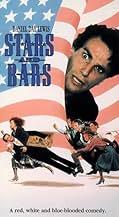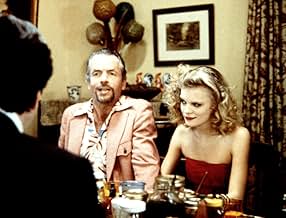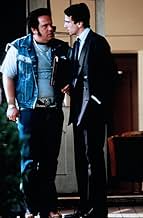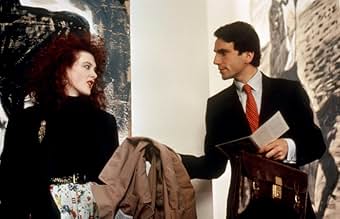IMDb RATING
4.9/10
1.1K
YOUR RATING
A British art expert travels across America in order to purchase a rare Renoir painting in the South but comes across some crazy characters in the process.A British art expert travels across America in order to purchase a rare Renoir painting in the South but comes across some crazy characters in the process.A British art expert travels across America in order to purchase a rare Renoir painting in the South but comes across some crazy characters in the process.
- Awards
- 1 win total
Daniel Day-Lewis
- Henderson Dores
- (as Daniel Day Lewis)
Featured reviews
A very strange fish-out-of-water comedy with straight-laced stiff-upper-lip British art dealer Daniel Day-Lewis sent down South to try to purchase a priceless painting from kooky patriarch Harry Dean Stanton and contending with the various family lunatics. The tone of the film is quite uneven and the comedic moments are more mildly amusing rather than laugh-out-loud funny. Other films and books have done both the "normal guy out of his depth" and lampoon of the Southern Gothic family more expertly, but that is not to indicate that the film does not have some memorable moments. Some of the supporting performances are well done, particularly Maury Chaykin's obnoxious Elvis-garbed bully son and Martha Plimpton, as the sex-crazed teenager, who accompanies Day-Lewis on his trip. Unfortunately, others like Joan Cusack, Glenne Headley, Will Patton and Laurie Metcalf are either stuck with overly broad roles or limited screen time. Pat O'Connor's direction is rather clumsy and rough resulting in a film that moves in starts and stops, and misses the mark more often than not. Arguably the most interesting reason to see the film is Day-Lewis himself. Usually he plays straight dramatic roles filled with sweaty angst, it is rare to see him in a comedy, much less playing such a well-intentioned, discombobulated dweeb. He is surprisingly appealing and throws himself body and soul into the part, even when the film does not remotely deserve such consideration. It is a shame that he has refrained from doing much comedy, because he does show some skill in frantic slapstick moments - whether running around a hotel trying to prevent the meeting of two women or escaping from gangsters buck naked after being forced to strip. Not to digress, but Day-Lewis' surprising full frontal nude scene during the strip and escape is certainly another plus for any fans of his as, much like comedy, nudity is something he rarely does in his dramas.
I remember standing in a long line to see this in Manhattan, and thinking that the New York parts were a perfect representation of the city at that moment in time. It's a weird vehicle for Daniel Day-Lewis, apart from his ability to play a perfect British upper class twit - I don't think he's done a comedy since (and certainly not before). The use of Joan Cusack as leading lady and love object is bizarre, too - up until this point she'd been relegated to kooky sidekick/friend of the heroine roles (Broadcast News springs immediately to mind), something she went back to almost immediately after this film. It's strange all around, but also a funny time capsule of sorts. I too wish it was out on DVD.
William Boyd's "Stars and Bars" - the book - stands in the great tradition of the English comic novel (Evelyn Waugh being one of Boyd's masters and inspirators). Now, I've seen the film only in German language... That's a pity because of the resulting demi-lack of Englishman-in-New-York-effects. As you can image, the German translation cannot be that perfect. I guess that the linguistical misunderstandings between the "hero" (Day Lewis) and the bizarre Georgian family with Anglophobic slursare are ten times funnier in the original version (as they are in the book). Anyway, I liked the film immediately and I'm happy to have taped it. Great cast! Unforgettable: Maury Chaykin as Elvis-like Freeborn.
It may be a far cry from classic screwball comedy, but even during its many forgettable moments this fish-out-of-water farce isn't a total write-off. Certainly there's nothing in it to justify the cold-blooded lack of confidence that killed it at the Box Office: the throwaway release it received is usually reserved for lame dogs someone wants put out of misery, and in this case it worked.
At least the film never pretends to be anything more than what it is: a self-consciously wacky social comedy with an outsider's exaggerated, broad-as-a-barn-door view of American manners, starring Daniel Day Lewis as a dapper English art appraiser who runs into an oddball collection of cartoon Confederate rebels while investigating a lost Renoir in backwoods Georgia. All the film needs is a laugh-track to become a respectable TV sitcom (a degenerate Beverly Hillbillies?), but director Pat O'Connor doesn't show much aptitude for low comedy, and the laughs collapse into a feeble slapstick conclusion, leaving the door wide open for a sequel which will never be made.
At least the film never pretends to be anything more than what it is: a self-consciously wacky social comedy with an outsider's exaggerated, broad-as-a-barn-door view of American manners, starring Daniel Day Lewis as a dapper English art appraiser who runs into an oddball collection of cartoon Confederate rebels while investigating a lost Renoir in backwoods Georgia. All the film needs is a laugh-track to become a respectable TV sitcom (a degenerate Beverly Hillbillies?), but director Pat O'Connor doesn't show much aptitude for low comedy, and the laughs collapse into a feeble slapstick conclusion, leaving the door wide open for a sequel which will never be made.
My review was written in March 1988 after watching the film at a Manhattan screening room.
In David Puttam's legacy at Columbia Pictures, "Stars and Bars" represents a major faux pas. Unfunny mixture of farce and misdirected satire has no conceivable audience apart from undiscriminating pay-cable viewers.
Project was developed by Puttna, but given to his ex-partner Sandy Lieberson to produce after Puttnam acceded to head of Columbia. Though an American picture, it features a high complement of U. K. personnel behind the camera.
Scripted by William Boyd from his novel, thin story line follows the misadventures of a Brit in America, or rather someone's view of what America is like (targets of Boyd's satire are all straw men). Daniel Day-Lewis plays the hapless hero, an art expert sent by his boss to acquire a rare Renoir painting (worth about $10,000,000) from hayseed Harry Dean Stanton, who claims to have bought it for $500 in France in 1946.
Bulk of the pic deals with Day-Lewis' interactions with Stanton's weird brood, including Maury Chaykin as his Elvis-imitating son who already has sold the painting to unscrupulous, rival New York art dealers. Nonsensical gags and caricatures represent a real comedown from Hollywood's cutesy but effective portrayal of Southern goofballs, especially in such funny films as the 1945 Fred MacMurray vehicle, "Murder, He Says".
Add to this concoctions some awkward bedroom farce (Day-Lewis unconvincingly juggling his new pickup, Joan Cusack, at an Atlanta hotelwith his fiancee Laurie Metcalf) that wouldn't pass muster as a West End farce for the tourist trade, and pic self-destructs rapidly. Helmer Pat O'Connor evidences no feel for comedy, having the cast overact unmercifully, except for standup comic Steven Wright (as Day-Lewis' business rival) who maintains his familiar deadpan pesona.
Day-Lewis is downright embarrassing, suffering through two extended nude chase scenes and nearly bursting a blood vessel in his uncharacteristic turn. Stanton is wasted in the sort of role he graduated from a decade ago and juve actress Martha Plimpton is miscast in a precocious temptress role.
Supporting cast is one long in-joke, featuring tons of New York talent whose presence will mean nothing to national audiences and add nothing to the picture, e.g., Spalding Gray, Rockets Redglare. Structurally the fact that Will Patton (recently impressive as the villain in "No Way Out") has a key role but doesn't show up on screen until two brief scenes in the final reel is mystifying.
Sting contributes an excellent theme song "An Englishman in New York", from his latest LP, which is pointlessly reprised near the end of the film.
In David Puttam's legacy at Columbia Pictures, "Stars and Bars" represents a major faux pas. Unfunny mixture of farce and misdirected satire has no conceivable audience apart from undiscriminating pay-cable viewers.
Project was developed by Puttna, but given to his ex-partner Sandy Lieberson to produce after Puttnam acceded to head of Columbia. Though an American picture, it features a high complement of U. K. personnel behind the camera.
Scripted by William Boyd from his novel, thin story line follows the misadventures of a Brit in America, or rather someone's view of what America is like (targets of Boyd's satire are all straw men). Daniel Day-Lewis plays the hapless hero, an art expert sent by his boss to acquire a rare Renoir painting (worth about $10,000,000) from hayseed Harry Dean Stanton, who claims to have bought it for $500 in France in 1946.
Bulk of the pic deals with Day-Lewis' interactions with Stanton's weird brood, including Maury Chaykin as his Elvis-imitating son who already has sold the painting to unscrupulous, rival New York art dealers. Nonsensical gags and caricatures represent a real comedown from Hollywood's cutesy but effective portrayal of Southern goofballs, especially in such funny films as the 1945 Fred MacMurray vehicle, "Murder, He Says".
Add to this concoctions some awkward bedroom farce (Day-Lewis unconvincingly juggling his new pickup, Joan Cusack, at an Atlanta hotelwith his fiancee Laurie Metcalf) that wouldn't pass muster as a West End farce for the tourist trade, and pic self-destructs rapidly. Helmer Pat O'Connor evidences no feel for comedy, having the cast overact unmercifully, except for standup comic Steven Wright (as Day-Lewis' business rival) who maintains his familiar deadpan pesona.
Day-Lewis is downright embarrassing, suffering through two extended nude chase scenes and nearly bursting a blood vessel in his uncharacteristic turn. Stanton is wasted in the sort of role he graduated from a decade ago and juve actress Martha Plimpton is miscast in a precocious temptress role.
Supporting cast is one long in-joke, featuring tons of New York talent whose presence will mean nothing to national audiences and add nothing to the picture, e.g., Spalding Gray, Rockets Redglare. Structurally the fact that Will Patton (recently impressive as the villain in "No Way Out") has a key role but doesn't show up on screen until two brief scenes in the final reel is mystifying.
Sting contributes an excellent theme song "An Englishman in New York", from his latest LP, which is pointlessly reprised near the end of the film.
Did you know
- TriviaA rejected score was composed by Elmer Bernstein.
- ConnectionsFeatured in The Nostalgia Critic: Should We Stop Method Acting? (2020)
- How long is Stars and Bars?Powered by Alexa
Details
Box office
- Budget
- $7,500,000 (estimated)
- Runtime
- 1h 34m(94 min)
- Color
- Sound mix
Contribute to this page
Suggest an edit or add missing content





































